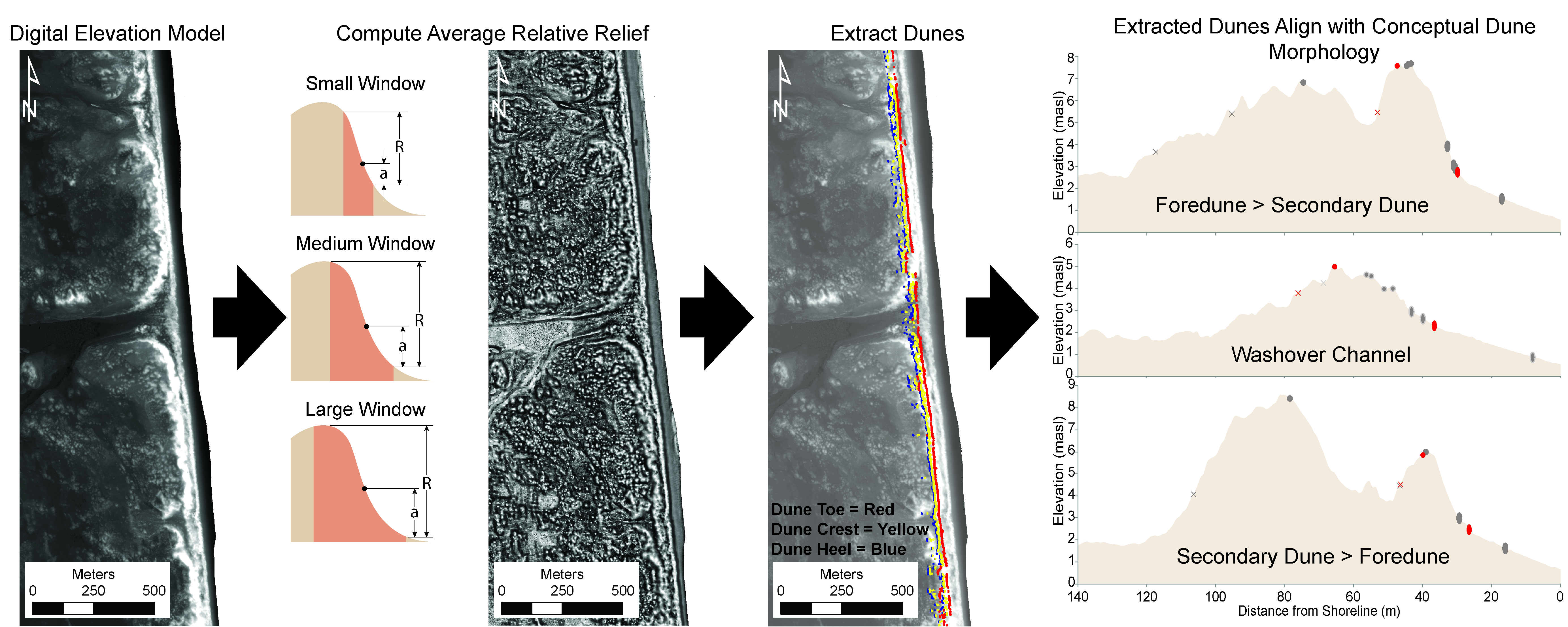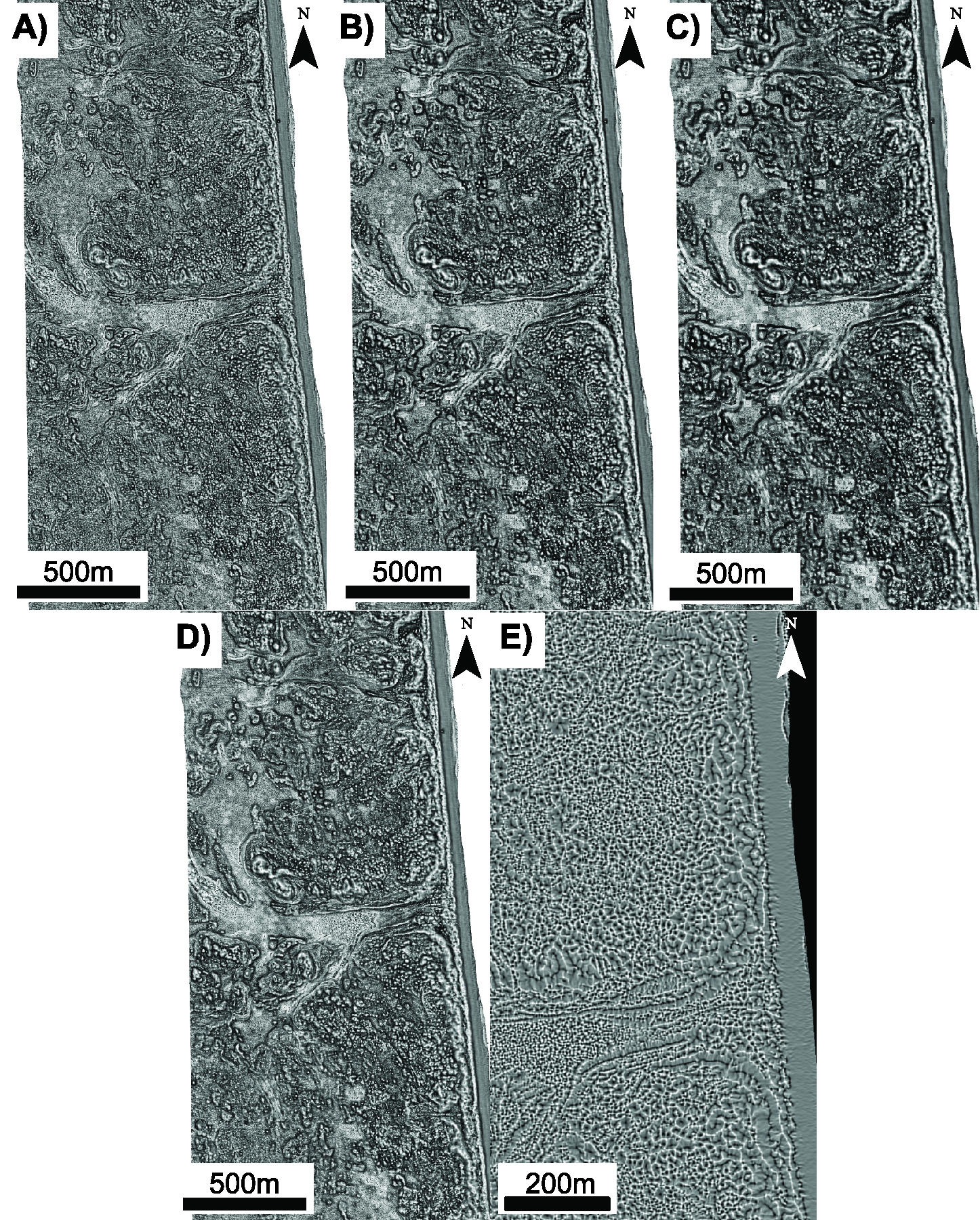This program implements the approach detailed in:
Wernette, P., C. Houser, and M.P. Bishop. (2016) An automated approach for extracting barrier island morphology from digital elevation models. Geomorphology, 262(1), 1-7. http:https://doi.org/10.1016/j.geomorph.2016.02.024.
This code can be compiled as follows:
g++ *.cpp -lm -O2 -o programname.exe
or
g++ *.cpp -lm -O2 -static -o programname.exe
The second compiling option will create a static stand-alone program which may be transferred from one device to another while maintaining function. NOTE: Compiling with relative_relief.cpp will not work since data_structures.cpp is not also compiled in the process.
This program functions by (1) importing an ENVI format DEM (.dat and .h file), (2) computing relative relief across 3 spatial scales, and (3) (OPTIONAL) extracting beach, dune, and island landscape features, and computing landform morphometrics (i.e. height, width, volume) from these landscape features.
Relative relief (RR) of every pixel in the input DEM is first computed *using a 2D moving window*, where the window size is specified by the params_rr.ini file.
The 2D window size will significant affect the ability to extract different landform morphometrics and subsequent landforms.
Landform morphometrics (i.e. dune toe, dune crest, dune heel, and all additional derivatives) are extracted along transects of the 2D computed relative relief values.
- Input filename (excluding extension)
- Window Size: This is the moving window diameter (i.e. kernel size) in picxels used to compute relative relief. Two additional scales of relative relief will also be computed by adding 2 to this user-specified window size.
- Desired Output Product:
rr: outputs relative relief rasters onlyshoreline: outputs shorelinedunetoe: outputs dune toedunecrest: outputs dune crestduneheel: outputs dune heelbackbarrier: outputs backbarrierlandforms: outputs all landform rasters AND landform metrics tableall: outputs all landform rasters, landform metrics table, AND relative relief rasters
- Output Data Type(s):
ascii: only outputs ascii fileenvi: only outputs ENVI format rasterboth: output both ascii and ENVI files
The default thresholds are as follows:
- Shoreline: 0.02 masl
- Dune Toe: 0.2
- Dune Crest: 0.8
- Dune Heel: 0.4
- BB Shoreline: 1.0 masl
Any of the default values can be changed by altering the params_rr.ini file that accompanies this program.
program.exe sample_ENVI_raster_filename 25 all both
Read in sample_ENVI_raster_filename as a raster (if available in ENVI format raster), compute relative relief at 25m, 27m, and 29m (assuming the raster has a 1m cell size), and write out all relative relief products as individual rasters, landform metrics rasters, and landform metrics table.
program.exe sample_ENVI_raster_filename 11 rr envi
Read in sample_ENVI_raster_filename as a raster (if available in ENVI format raster), compute relative relief at 11m, 13m, and 15m (assuming the raster has a 1m cell size), and write out all relative relief products as individual rasters.
program.exe sample_ENVI_raster_filename 3 landforms both
Read in sample_ENVI_raster_filename as a raster (if available in ENVI format raster), compute relative relief at 25m, 27m, and 29m (assuming the raster has a 1m cell size), and write out landform metrics rasters and landform metrics table.
This program was developed by Phil Wernette as part of his PhD Thesis from 2017 ("Assessing the Role of Framework Geology on Barrier Island Geomorphology") and Geomorphology paper from 2016 (Wernette, P., C. Houser, and M.P. Bishop. (2016) An automated approach for extracting barrier island morphology from digital elevation models. Geomorphology, 262(1), 1-7. http:https://doi.org/10.1016/j.geomorph.2016.02.024.)
For questions related to this program, please contact:
Phil Wernette [email protected]




